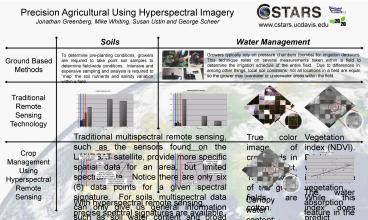Precision Agricultural Using Hyperspectral Imagery - PowerPoint PPT Presentation
1 / 1
Title: Precision Agricultural Using Hyperspectral Imagery
1
Precision Agricultural Using Hyperspectral
Imagery Jonathan Greenberg, Mike Whiting, Susan
Ustin and George Scheer
Soils
Water Management
Growers typically rely on pressure chambers
(bombs) for irrigation decisions. This technique
relies on several measurements taken within a
field to determine the irrigation schedule of the
entire field. Due to differences in, among other
things, local soil conditions, not all locations
in a field are equal, so the grower may overwater
or underwater areas within the field.
To determine pre-planting conditions, growers are
required to take point soil samples to determine
field-wide conditions. Intensive and expensive
sampling and analysis is required to map the
soil nutrients and salinity variation within a
field.
Ground Based Methods
Traditional Remote Sensing Technology
Traditional multispectral remote sensing, such as
the sensors found on the LANDSAT satellite,
provide more specific spatial data for an area,
but limited spectral data. Notice there are only
six (6) data points for a given spectral
signature. For soils, multispectral data can
only give us general information such as soil
water content and broad differences in soil
types. For vegetation, multispectral data can
predict vegetation levels, to an extent, but
cannot determine specific crop stressors.
True color image of crop fields in late August,
1999. Most of the green fields are cotton.
Vegetation index (NDVI). Brighter values
indicate more vegetation. While this index does
predict vegetation levels, it does not indicate
what stressors are present.
Crop Management Using Hyperspectral Remote Sensing
Water absorption features indicates canopy water
content
Water stressed cotton
Well irrigated cotton
Red edge position indicates plant stress
The water absorption feature in the canopy
spectra is related to the moisture in the leaf as
are pressure bomb measurements. We have found
that the spectral measurements relate directly to
the bomb measurements, and that differences in
this relationship are more likely due to
inaccuracies in the pressure bomb measurements
than the spectral measurements.
Canopy water content brighter values indicate
more canopy water. With hyperspectral remote
sensing information, growers can direct their
irrigation far more precisely than with point
samples from a pressure bomb.
With hyperspectral remote sensing, precise
spectral signatures are available for every pixel
within the image. Current research is
investigating methods to use these signatures to
extract information necessary to make critical
decisions concerning soil preparation and
preplant conditions, stand conditions including
canopy water and insect damage, and harvest
conditions.































